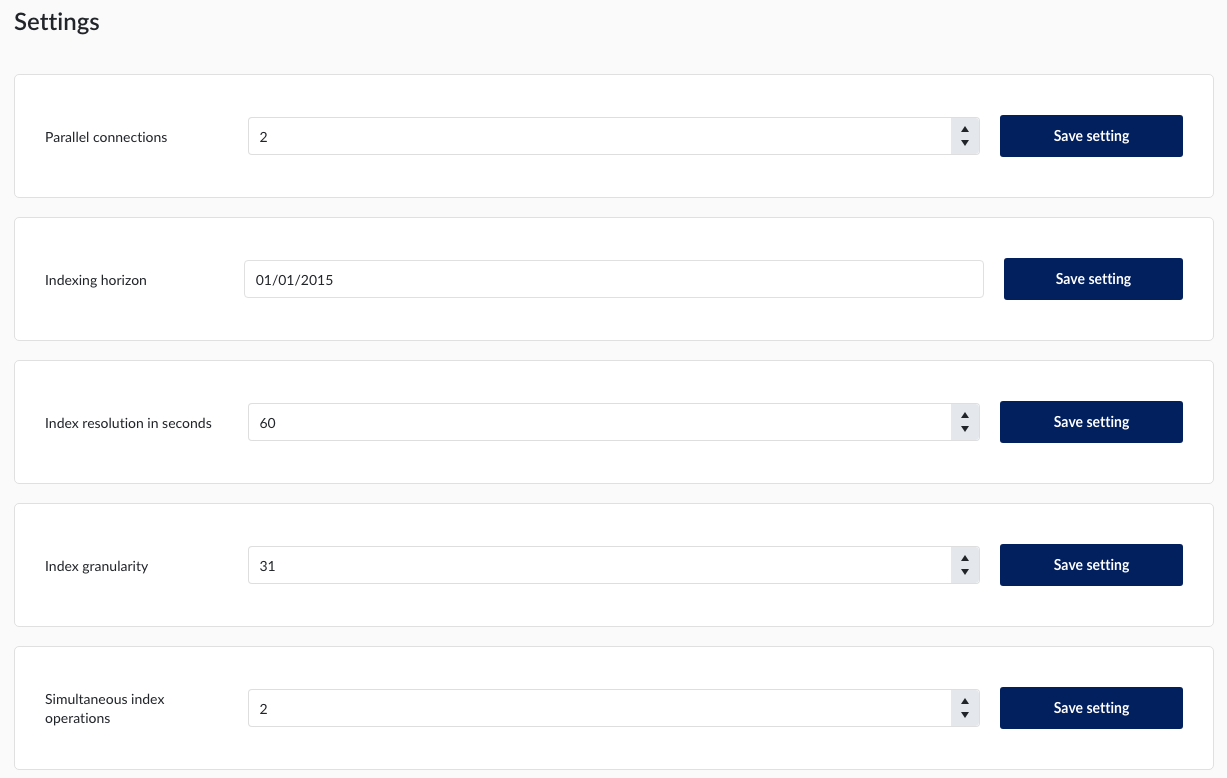Settings
TrendMiner uses certain connection settings to optimize the performance of the historian connection. By default, 2 parallel connections are used. In most cases, the value for the “Historian Parallelism” setting should equal the number of cores on your historian server.
The setting is a global setting, but parallel connections can also be set per datasource (in the Data -> Data sources menu) as an override. Changing the global default will not update the existing overrides. They will keep the current value set as override.
Note
Consult TrendMiner support at support@trendminer.com if you are experiencing performance issues or believe it would be appropriate to change this setting.
The indexing horizon shows the earliest date from where tags are indexed. Tag data before this date will not be available for TrendMiner analysis. The default indexing horizon is January 1st, 2015 (reference 1).
When increasing the index horizon (e.g. from 2015 to 2010), already indexed tags will automatically resume indexing up until the new horizon whenever these tags are used in charting or by monitors.
When decreasing the index horizon (e.g. from 2010 to 2015), existing indexes will not automatically be deleted but new tags (or when re-indexing already indexed tags) will index only up till the new index horizon.
The index resolution defines the level of detail of the index. For a resolution of 1 minute (the default) the index contains up to 4 points per minute.
Valid index resolutions are:
Minimum: 5 (five seconds)
Maximum: 86400 (one day)
The index resolution should be able to evenly divide the total seconds in a day and therefore should be a factor of 86400
Caution
If required, an index resolution of 1 second can be configured, though this is not officially supported and might lead to performance issues
Warning
Changing the index resolution will delete all existing tag indexes.
Warning
As you can only search for time periods with a minimal duration of 2 times the index resolution searches can become invalid by lowering the index resolution (e.g. from 30 seconds to 1 minute). As a result search-based monitors can go to a system-disabled state (meaning these monitors will no longer trigger alerts).
The index granularity defines the time periods which are fetched from the datasource to build the index during the indexing process. The smaller the time periods, the more calls have to be made to the datasource, causing greater overheads and slower indexing. The larger the granularity, the greater the risk on connection time-outs and the higher the memory consumption.
The default granularity is 1 month ("1M").
Valid index granularities include, for example, "1D" (1 day) or "5D" (5 days). Changing the granularity will not impact tags which are already indexed.
This value sets the number of simultaneous index operations. The default value is 2, which means only 2 indexing tasks can be running at any given time. Periods of different tags will be interleaved, giving higher priority to most recent periods, ensuring all tags will index at a similar pace.
Please contact TrendMiner support before changing this setting.
